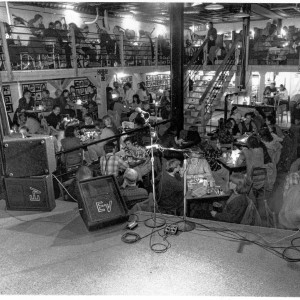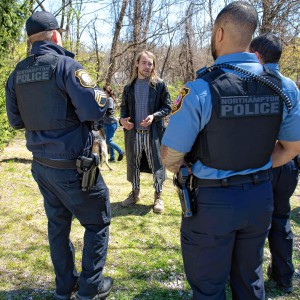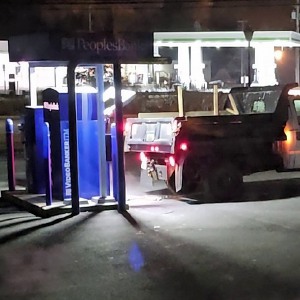Character-building: Puppet maker delights in bringing out creativity in teaching the art to kids
| Published: 04-13-2023 1:54 PM |
Wild-looking creatures roam Eric Weiss’ unassuming South Hadley home. But there is no reason for the neighbors to be alarmed. The creatures are puppets made by Weiss, owner of Homeslice Puppetry, a portal to a wide world of puppets, from workshops to parades to film festivals.
Most recently, Weiss helped produce the World Puppet Day 2023 virtual parade for World Puppet Day on March 21. The YouTube video features more than 130 puppets marching across the screen against different backgrounds, and includes the artistry of 75 puppeteers in 14 countries, from Iran to South Africa to Japan, including a number of Weiss’ puppets.
Weiss’s love of puppets has been lifelong. “The Great Muppet Caper” was the first movie he saw in a theater, and he became a huge Jim Henson fan. “He’s my hero,” Weiss says unabashedly. Even before that, “ ‘The Muppets’ was the one television show my parents let me stay up late to watch.”
But it was just a hobby, not a career. After earning a bachelor’s degree in environmental studies at SUNY Buffalo, Weiss spent the next several years clearing hiking trails across the country, from Hawaii to Maine, for AmeriCorps and the Student Conservation Association.
It was while working for Nature’s Classroom, an environmental education program in Charlton, that Weiss began to get serious about puppets, creating a course in puppet-making.
He taught himself with the aid of online courses including Stan Winston’s School of Character Arts. Winston won four Academy Awards for his special makeup effects in films including the “Alien” movies, “Jurassic Park” and “The Terminator.” Weiss won first place for his Minion puppet in in a puppet-building contest organized by Winston teacher B.J. Guyer.
Weiss found he enjoyed teaching about puppets as much as making them. “I’m a teacher first, and a puppet-maker second,” he says. “It was teaching that steered me toward puppets.”
He made the leap to full-time puppet-maker and teacher soon thereafter, moving to Easthampton in 2019 and starting Homeslice Puppetry, offering classes and workshops in puppet-making.
Article continues after...
Yesterday's Most Read Articles
 The Iron Horse rides again: The storied Northampton club will reopen at last, May 15
The Iron Horse rides again: The storied Northampton club will reopen at last, May 15
 Homeless camp in Northampton ordered to disperse
Homeless camp in Northampton ordered to disperse
 Authorities ID victim in Greenfield slaying
Authorities ID victim in Greenfield slaying
 $100,000 theft: Granby Police seek help in ID’ing 3 who used dump truck to steal cash from ATM
$100,000 theft: Granby Police seek help in ID’ing 3 who used dump truck to steal cash from ATM
 UMass football: Spring Game closes one chapter for Minutemen, 2024 season fast approaching
UMass football: Spring Game closes one chapter for Minutemen, 2024 season fast approaching
 Final pick for Amherst regional superintendent, from Virgin Islands, aims to ‘lead with love’
Final pick for Amherst regional superintendent, from Virgin Islands, aims to ‘lead with love’
Months later the pandemic hit, and he had to adapt to teaching online, and found himself teaching second graders in San Francisco and seventh graders in Vinalhaven, Maine.
Weiss next started the Western Massachusetts Puppetry Guild, one of four guilds in the Puppeteers of America’s Northeast region. He didn’t know what to expect, but 40 people responded, and today the group meets monthly online, comparing notes, watching videos, and critiquing each other’s work.
There are many kinds of puppets, including marionettes, full-body figures controlled from above with strings; hand puppets, operated by the puppeteer’s fingers; shadow puppets, where silhouettes are projected on a screen or wall; sock puppets, made to look like animals or people; mechanical puppets, movement manipulated by a hand lever attached to a rod; and ventriloquist figures made of hardwood.
Weiss has made many of them, in a range of sizes and materials.
A good puppet has to be lightweight, first and foremost, Weiss says, and it must move easily, especially around the mouth. After that, “it’s about getting the look right.”
After making sketches, he descends to his basement studio, where his puppets come to life. He surrounds himself with bright, cheerful colors in this otherwise dark space, having painted the cement floor teal, with purple and blue walls.
Weiss is resourceful with materials. It starts with lots of foam — several kinds, depending on the style of puppet. He cuts the foam with a razor blade and paints it with silicon, a substance that “only adheres to itself,” he says. It forms bonds around the porous foam that hold it in place, over which he adds layers to achieve the right texture and shade.
He uses found and “upcycled” materials in creative ways. An owl’s wings move up and down, and it turns from side to side with the aid of an ordinary corkscrew. Green pom-poms form a broccoli floret.
The storage area might look ghoulish to the uninitiated: One drawer is filled with hands, another is labeled “eyes/beaks/teeth.”
Weiss only dabbles as a puppeteer. His twin passions are making puppets, and teaching children how to make their own. In as little as a two-hour workshop, he can teach students to make imaginative sock puppets animated with cardboard mouthpieces and foam skulls.
Weiss feels that children are so distracted by technology these days that “they don’t have enough opportunities to be truly creative.” The hands-on activity of making a puppet “really draws out their creativity, and I am continually amazed at the results.”
“I’m in awe of the creativity and ideas kids come up with,” he says.
Puppets have long captivated American audiences, from Howdy Doody to Mortimer Snerd; Shari Lewis’ Lambchop; and Miss Piggy and Kermit the Frog.
But puppetry’s roots are deeper, dating back to Egypt and ancient Greece. The Romans are thought to have brought theatrical puppets to Italy, and from there they spread to Europe. The Punch and Judy show originated in Italy in the 1500s; “The Adventures of Pinocchio” by Carlo Collodi was published in 1883.
“It’s a different kind of entertainment,” says Weiss about our enduring fascination. “Puppets involve every kind of art: theater, painting, sculpting, performing.”
While puppets mainly entertain us, their impact can be profound. They can be scary or cuddly, tiny or tall. Actors who have worked with puppets have said that they find themselves thinking that they have been talking to a real person, he says.
Puppets have educational and therapeutic uses, too. Traumatized children, for instance, have been known to more easily unburden themselves to a puppet rather than an adult.
Weiss’s newest commission is to make 165 puppets for the Hispanic Health Council, a community-based organization for Hispanics, Latinos, and other vulnerable communities in Connecticut’s poorest cities.
The Council uses 33 puppet characters to promote healthy nutrition and exercise for children from preschool through third grade; Weiss will make five complete sets for puppet shows with titles such as “Happy Heart,” “Grandma Visits the Doctor” and “Tommy Enjoys Exercising.” The project, his biggest yet, will take Weiss two years to complete.
The broccoli is done, “Bartlett” the pear is nearly finished, and Weiss holds a round, softball-size piece of foam that will eventually become an orange.
Weiss gave up trail-making when it became too physically demanding, but building puppets satisfies his love of the tactile world, a love he shares with his young students. “Puppets inspire all kinds of creativity,” he muses, “and get us to use our hands to make beautiful things.”

 Valley Bounty: Grass-fed animals that feed the grass: Gwydyr Farm in Southampton focuses on ‘restoring the connection between land, food and people’
Valley Bounty: Grass-fed animals that feed the grass: Gwydyr Farm in Southampton focuses on ‘restoring the connection between land, food and people’ Weekly Food Photo Contest: This week’s winner: Mary Chicoine of Easthampton
Weekly Food Photo Contest: This week’s winner: Mary Chicoine of Easthampton  Speaking of Nature: A romantic evening for two birders — To hear the wonderful sounds of the Saw-whet Owl one must go outside at night
Speaking of Nature: A romantic evening for two birders — To hear the wonderful sounds of the Saw-whet Owl one must go outside at night Speaking of Nature: Where have all the birds gone?: They’re there, and here’s a handy tool to keep track of their appearances
Speaking of Nature: Where have all the birds gone?: They’re there, and here’s a handy tool to keep track of their appearances
